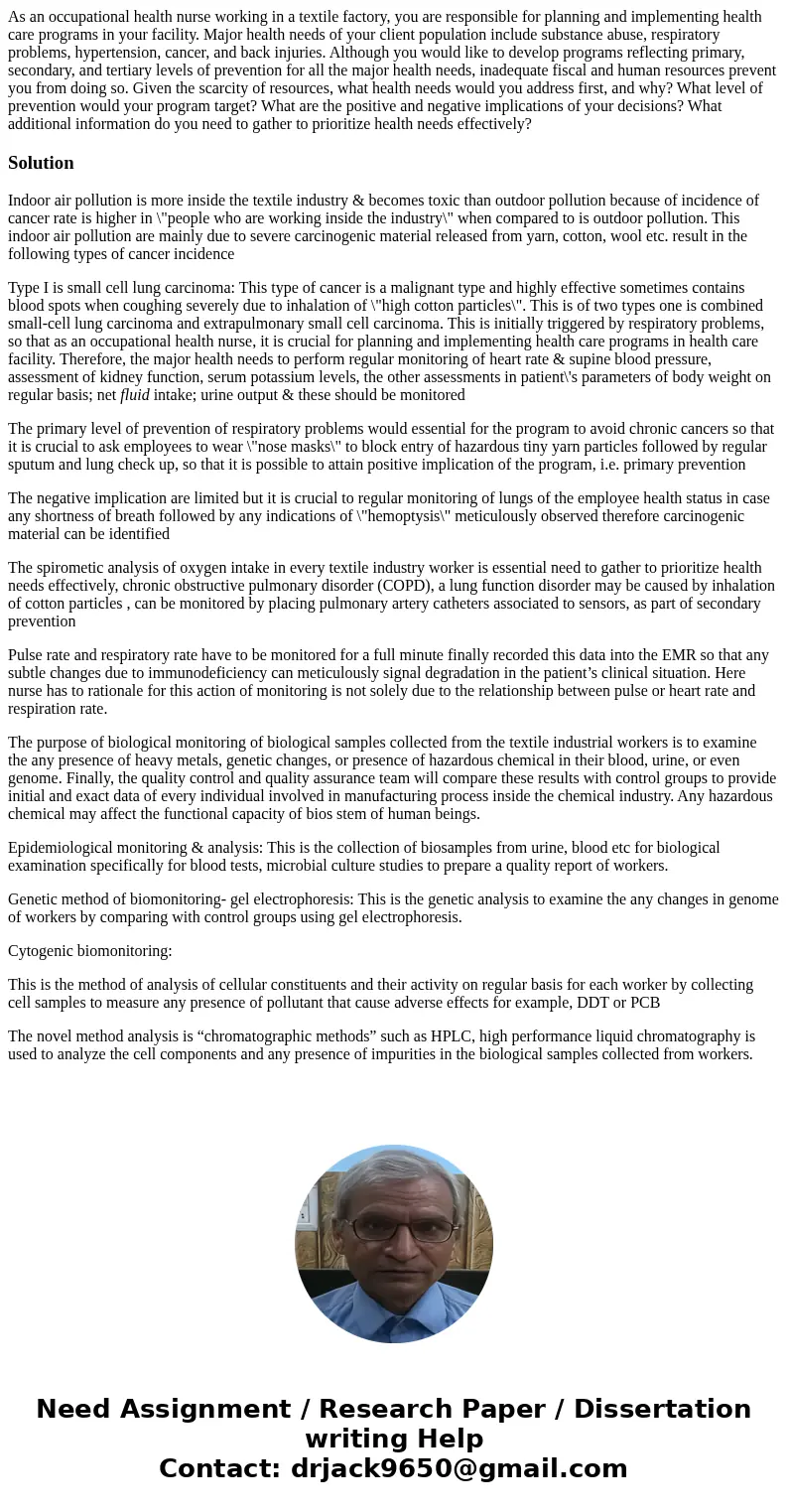As an occupational health nurse working in a textile factory
As an occupational health nurse working in a textile factory, you are responsible for planning and implementing health care programs in your facility. Major health needs of your client population include substance abuse, respiratory problems, hypertension, cancer, and back injuries. Although you would like to develop programs reflecting primary, secondary, and tertiary levels of prevention for all the major health needs, inadequate fiscal and human resources prevent you from doing so. Given the scarcity of resources, what health needs would you address first, and why? What level of prevention would your program target? What are the positive and negative implications of your decisions? What additional information do you need to gather to prioritize health needs effectively?
Solution
Indoor air pollution is more inside the textile industry & becomes toxic than outdoor pollution because of incidence of cancer rate is higher in \"people who are working inside the industry\" when compared to is outdoor pollution. This indoor air pollution are mainly due to severe carcinogenic material released from yarn, cotton, wool etc. result in the following types of cancer incidence
Type I is small cell lung carcinoma: This type of cancer is a malignant type and highly effective sometimes contains blood spots when coughing severely due to inhalation of \"high cotton particles\". This is of two types one is combined small-cell lung carcinoma and extrapulmonary small cell carcinoma. This is initially triggered by respiratory problems, so that as an occupational health nurse, it is crucial for planning and implementing health care programs in health care facility. Therefore, the major health needs to perform regular monitoring of heart rate & supine blood pressure, assessment of kidney function, serum potassium levels, the other assessments in patient\'s parameters of body weight on regular basis; net fluid intake; urine output & these should be monitored
The primary level of prevention of respiratory problems would essential for the program to avoid chronic cancers so that it is crucial to ask employees to wear \"nose masks\" to block entry of hazardous tiny yarn particles followed by regular sputum and lung check up, so that it is possible to attain positive implication of the program, i.e. primary prevention
The negative implication are limited but it is crucial to regular monitoring of lungs of the employee health status in case any shortness of breath followed by any indications of \"hemoptysis\" meticulously observed therefore carcinogenic material can be identified
The spirometic analysis of oxygen intake in every textile industry worker is essential need to gather to prioritize health needs effectively, chronic obstructive pulmonary disorder (COPD), a lung function disorder may be caused by inhalation of cotton particles , can be monitored by placing pulmonary artery catheters associated to sensors, as part of secondary prevention
Pulse rate and respiratory rate have to be monitored for a full minute finally recorded this data into the EMR so that any subtle changes due to immunodeficiency can meticulously signal degradation in the patient’s clinical situation. Here nurse has to rationale for this action of monitoring is not solely due to the relationship between pulse or heart rate and respiration rate.
The purpose of biological monitoring of biological samples collected from the textile industrial workers is to examine the any presence of heavy metals, genetic changes, or presence of hazardous chemical in their blood, urine, or even genome. Finally, the quality control and quality assurance team will compare these results with control groups to provide initial and exact data of every individual involved in manufacturing process inside the chemical industry. Any hazardous chemical may affect the functional capacity of bios stem of human beings.
Epidemiological monitoring & analysis: This is the collection of biosamples from urine, blood etc for biological examination specifically for blood tests, microbial culture studies to prepare a quality report of workers.
Genetic method of biomonitoring- gel electrophoresis: This is the genetic analysis to examine the any changes in genome of workers by comparing with control groups using gel electrophoresis.
Cytogenic biomonitoring:
This is the method of analysis of cellular constituents and their activity on regular basis for each worker by collecting cell samples to measure any presence of pollutant that cause adverse effects for example, DDT or PCB
The novel method analysis is “chromatographic methods” such as HPLC, high performance liquid chromatography is used to analyze the cell components and any presence of impurities in the biological samples collected from workers.

 Homework Sourse
Homework Sourse